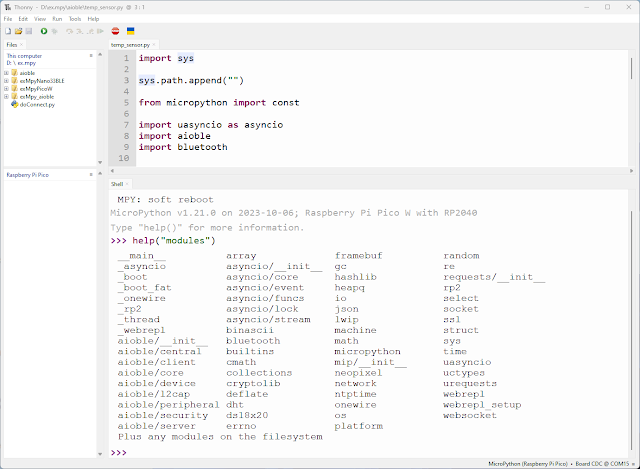MicroPython bluetooth example using aioble library, between Raspberry Pi Pico W and ESP32-C3. (Both run MicroPython 1.21.0)
With recent update of MicroPython, bluetooth is supported in Raspberry Pi Pico
W build.
The official guide "Connecting to the Internet with Raspberry Pi Pico W book (2023-06-14)" updated with example using bluetooth.
Read my previous post "Prepare MicroPython Bluetooth service example on Raspberry Pi Pico W".
Refer to
MicroPython libraries document - bluetooth, higher-level
aioble library
is recommended. aioble provides an object-oriented, asyncio-based wrapper for
MicroPython's bluetooth API.
(* This module is still under development
and its classes, functions, methods and constants are subject to change.)
This video introduce the alternative using aioble library, run on
Raspberry Pi Pico W
and Espressif ESP32-C3-DevKitM-1, both run MicroPython v1.21.0.
Notice that aioble is included in Raspberry Pi Pico W MicroPython v1.21.0, but not in v1.20.0.
Fail in await connection.disconnected() using aioble library, and solution.
In above MicroPython bluetooth example using aioble library, temp_sensor.py crash in the following line after connected for a while.
await connection.disconnected()
while connection.is_connected():
await asyncio.sleep_ms(500)
As record, both py code listed here.
temp_sensor.py
import sys
sys.path.append("")
from micropython import const
import uasyncio as asyncio
import aioble
import bluetooth
import random
import struct
# org.bluetooth.service.environmental_sensing
_ENV_SENSE_UUID = bluetooth.UUID(0x181A)
# org.bluetooth.characteristic.temperature
_ENV_SENSE_TEMP_UUID = bluetooth.UUID(0x2A6E)
# org.bluetooth.characteristic.gap.appearance.xml
_ADV_APPEARANCE_GENERIC_THERMOMETER = const(768)
# How frequently to send advertising beacons.
_ADV_INTERVAL_MS = 250_000
# Register GATT server.
temp_service = aioble.Service(_ENV_SENSE_UUID)
temp_characteristic = aioble.Characteristic(
temp_service, _ENV_SENSE_TEMP_UUID, read=True, notify=True
)
aioble.register_services(temp_service)
# Helper to encode the temperature characteristic encoding (sint16, hundredths of a degree).
def _encode_temperature(temp_deg_c):
return struct.pack("<h", int(temp_deg_c * 100))
# This would be periodically polling a hardware sensor.
async def sensor_task():
t = 24.5
while True:
temp_characteristic.write(_encode_temperature(t))
t += random.uniform(-0.5, 0.5)
await asyncio.sleep_ms(1000)
# Serially wait for connections. Don't advertise while a central is
# connected.
async def peripheral_task():
while True:
async with await aioble.advertise(
_ADV_INTERVAL_MS,
name="mpy-temp",
services=[_ENV_SENSE_UUID],
appearance=_ADV_APPEARANCE_GENERIC_THERMOMETER,
) as connection:
print("Connection from", connection.device)
#await connection.disconnected()
while connection.is_connected():
await asyncio.sleep_ms(500)
print("Dis-connected")
# Run both tasks.
async def main():
t1 = asyncio.create_task(sensor_task())
t2 = asyncio.create_task(peripheral_task())
await asyncio.gather(t1, t2)
asyncio.run(main())
import sys
sys.path.append("")
from micropython import const
import uasyncio as asyncio
import aioble
import bluetooth
import random
import struct
# org.bluetooth.service.environmental_sensing
_ENV_SENSE_UUID = bluetooth.UUID(0x181A)
# org.bluetooth.characteristic.temperature
_ENV_SENSE_TEMP_UUID = bluetooth.UUID(0x2A6E)
# Helper to decode the temperature characteristic encoding (sint16, hundredths of a degree).
def _decode_temperature(data):
return struct.unpack("<h", data)[0] / 100
async def find_temp_sensor():
# Scan for 5 seconds, in active mode, with very low interval/window (to
# maximise detection rate).
async with aioble.scan(5000, interval_us=30000, window_us=30000, active=True) as scanner:
async for result in scanner:
# See if it matches our name and the environmental sensing service.
if result.name() == "mpy-temp" and _ENV_SENSE_UUID in result.services():
return result.device
return None
async def main():
device = await find_temp_sensor()
if not device:
print("Temperature sensor not found")
return
try:
print("Connecting to", device)
connection = await device.connect()
except asyncio.TimeoutError:
print("Timeout during connection")
return
async with connection:
try:
temp_service = await connection.service(_ENV_SENSE_UUID)
temp_characteristic = await temp_service.characteristic(_ENV_SENSE_TEMP_UUID)
except asyncio.TimeoutError:
print("Timeout discovering services/characteristics")
return
while True:
temp_deg_c = _decode_temperature(await temp_characteristic.read())
print("Temperature: {:.2f}".format(temp_deg_c))
await asyncio.sleep_ms(1000)
asyncio.run(main())
Next:
~ MicroPython bluetooth remote control LED between Raspberry Pi Pico W and ESP32-C3, using aioble library.


Comments
Post a Comment